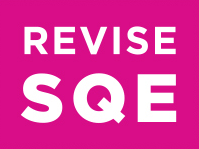Understanding the SQE2 exam format is crucial for effective preparation. This section explains the key SQE exam components for the practical skills assessment.
The SQE2 assessment is challenging as it asks candidates to put into practice the knowledge that they acquired for SQE1. This style of assessment is likely to be different from what you will have experienced before.
The Revise SQE series will alleviate some of those concerns, with guidance on preparing for the SQE assessment, tips on how to approach the skills-based assessments and detailed commentaries on sample answers to aid your revision.
SQE2 written assessments
- There are 12 written assessments, which take place over three days
- You will sit four assessments per day
- There will be two assessments in the first session, lasting a total of 1 hour 30 minutes
- There will then be a break of 15 minutes
- This is followed by two more assessments in the second session, lasting a total of 1 hour 45 minutes
SQE2 oral assessments
There are four SQE2 oral assessments: two for client interview and attendance note/legal analysis and two for advocacy. They will take place over two half days, and on each half day you will take one interview assessment and one advocacy assessment.
Oral Assessment Format
- Face-to-face with trained assessors (who are often actors)
- Real-world scenarios in professional settings
- Assessment of both skills and legal knowledge
Written Assessment Format
- Computer-based in exam centres
- Practical tasks like drafting documents or analysing cases
- Closed-book format (no notes allowed)
Interview and attendance note/legal analysis assessment
- You will be given some documentation and have 10 minutes to prepare for the interview
- The interview will last 25 minutes
- After the interview, you will have a further 25 minutes to write up the attendance note and legal analysis by hand
Advocacy assessment
- You will be provided with documentation and have 45 minutes to prepare for the assessment
- The advocacy assessment will last for 15 minutes
How is SQE2 marked?
Each of the SQE2 skills has its own set of assessment criteria. The Revise SQE: Legal Skills for SQE2 series will include the following:
Oral skills: the criteria are outlined in the introductory chapters of Oral Skills for SQE2: Client Interviewing and Negotiation and Oral Skills for SQE2: Advocacy.
Written skills: the criteria are outlined at the beginning of each chapter in our books covering the written skills for different legal contexts
The assessment is marked against the relevant criteria using the following scale:
A. Superior performance: well above the competency requirements of the assessment.
B. Clearly satisfactory: clearly meets the competency requirements of the assessment.
C. Marginal pass: on balance, just meets the competency requirements of the assessment.
D. Marginal fail: on balance, just fails to meet the competency requirements of the assessment.
E. Clearly unsatisfactory: clearly does not meet the competency requirements of the assessment.
F. Poor performance: well below the competency requirements of the assessment.
Your mark will be calculated by converting the grade into a numerical mark, with A representing 5 marks and F representing 0 marks.
The scaled scoring system
In January 2025 the SRA introduced a scaled scoring system for all SQE2 assessments.
This approach is designed to ensure that candidate scores are comparable across different assessment sittings, thereby providing a fair and consistent measure of candidate performance. The same system has already been implemented for all SQE1assessments.
The scaled scoring system works in the following way:
- Initially, candidates will receive a ‘raw score’ based on their performance across the 16 assessment stations in SQE2.
- A pass mark is then set for each assessment window. The pass mark is determined using statistical methods that account for any differences in question difficulty. This ensures fairness across different exam versions.
- Candidate raw scores are then converted to a common scale ranging from 0 to 500, with the pass mark consistently set at 300. This standardisation allows for direct comparisons between candidates’ performances, regardless of the specific assessments they completed.
When you access your results, you will be able to see:
- a detailed breakdown of your results by assessment station (results will be expressed as marks from 0 to 5 for each assessment criterion across each of the 16 assessment stations).
- your overall mark expressed as a percentage.
- your scaled score out of 500 – remember that the pass mark will always be set at 300.
For more information about the scaled scoring system, visit
https://sqe.sra.org.uk/SQEHomePage.
It is very important that you are aware of the standard you are required to meet. The competence standard is that of a Day One Solicitor, which is mapped against Level 3 of the Threshold Standard for the Statement of Solicitor Competence. This is available on the SRA website, and we would encourage you to review this prior to sitting your SQE2 assessment.
The assessors
In terms of who will be assessing you against this standard and the relevant skills criteria, the interview will be marked by the person you are interviewing, while the remaining assessments (attendance note, advocacy and all written skills) will be marked by a solicitor. All assessors will have received training on how to assess a candidate’s performance against the relevant criteria. It is therefore essential that you tackle your assessments in the same way that you would if you were a fully qualified solicitor on the first day of practice – with professionalism, confidence and calmness. This will come across to the assessors in the examination itself: remember that they are fundamentally assessing your suitability for practice!
